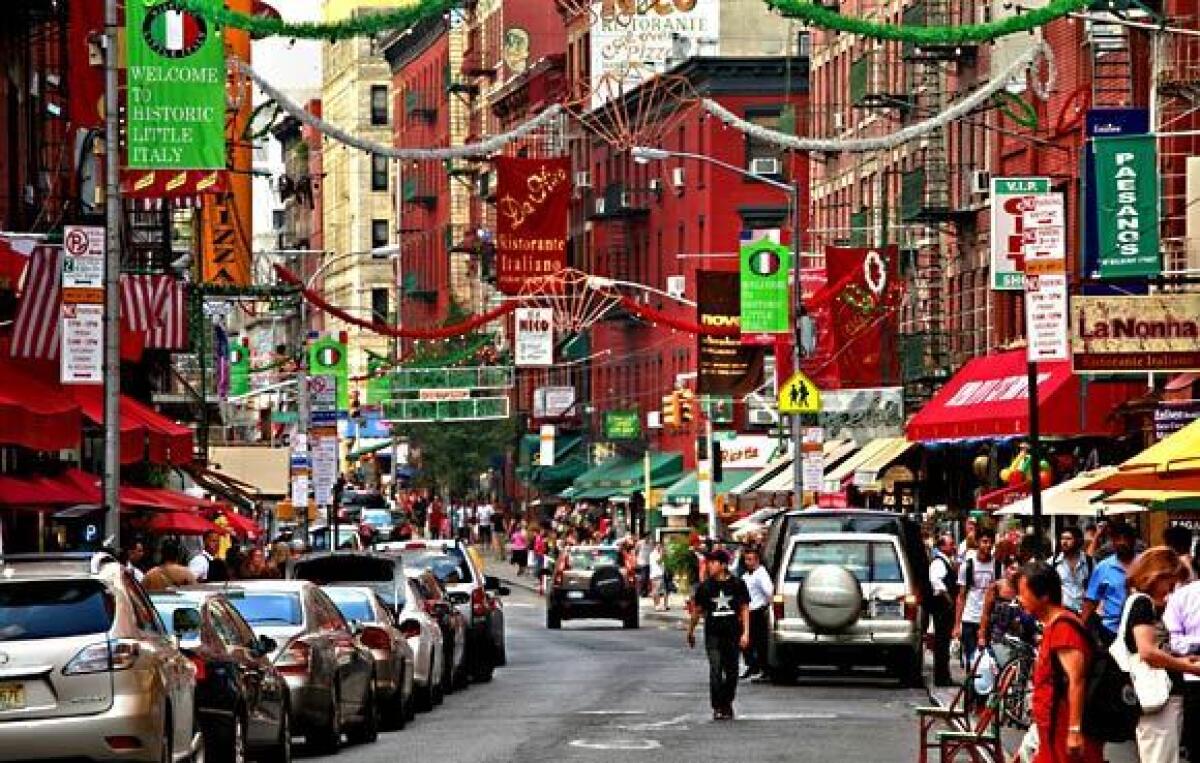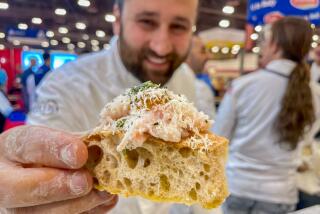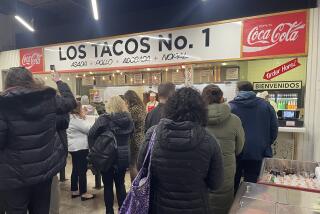The food battle for New York’s Little Italy

A family from the Midwest formed a crescent around the posted menu outside an Italian restaurant on Mulberry Street, the main (and only) drag of Manhattan’s shrinking Little Italy. It didn’t take long for the Latino restaurant barker — the guys who stand on the sidewalk trying to lure in the indecisive and hungry — to pounce: “Ciao, bellas,” he said, using the Spanish plural of the Italian noun. “Come in and eat,” he added, motioning with a sweep of his arm toward the open door. The family, though, thought better of it and moved on.
Welcome to Little Italy. Once a ghetto for new Italian immigrants, the neighborhood stretched south to north from Canal to Houston streets and east to west from Bowery to Lafayette Street. But as Italian immigrants made money, the prospect of more space and better living conditions lured them to other parts of Manhattan or the outer boroughs, and Chinatown expanded right up to Mulberry Street.
The neighborhood is now a shell of its former self, an anachronism of fake accents and generally mediocre restaurants, frozen in a time warp when eating sloppily executed “I-talian” cuisine was the norm among New Yorkers. Mulberry Street’s sidewalks are populated by tourists who may not know their farfalle from their fusilli but have the impression that the most authentic Italian experience in New York can be found here.
Photos: Restaurants of New York City’s Little Italy
Italian has always been the cuisine of choice for New York. You don’t need to walk more than a block or two most anywhere in Manhattan to find a restaurant serving pasta and red sauce. But in recent years, a new wave of Italian restaurants has appeared, run by chefs that have taken the cuisine up a notch. The results have turned Italian into the new French cuisine. It’s no longer cucina povera, comfort food, but splurge-worthy and Michelin-starred.
Some examples include Locanda Verde, Scarpetta, Marea and Maialino, among many others, and this doesn’t include the recent wave of outstanding Neapolitan pizzerias that have opened in the Big Apple.
Little Italy, however, has been left out of this trend, until recently. In the last year, restaurants serving inspired Italian cuisine have popped up on Mulberry Street. They’re in Nolita — an acronym New Yorkers mistake as North of Little Italy, but according to the Italian American Museum on Mulberry Street, it means Northern Little Italy. Together with a few new night-life spots on Mulberry, these places are bringing back locals to a street that has been colonized by tourists for decades.
Two people who are (unintentionally) leading the way are Rich Torrisi and Mario Carbone, Italian American chefs from Westchester County and Queens, respectively. Both logged time in the kitchens of celebrated New York Italian restaurants before jointly opening Torrisi Italian Specialties in early 2010. The restaurant, whose location on Mulberry is simply a coincidence because they liked the space, made appearances on almost every New York restaurant critic’s end-of-year best new restaurants of 2010 list.
But what makes Torrisi particularly interesting is that it’s serving Italian American fare — that much maligned and disrespected cuisine that most talented Italian-leaning chefs won’t touch with a 10-foot spatula.
“Italian American cuisine has a bad reputation because it’s bad,” Torrisi, 31, said when I sat down with the two chefs just before the lunch rush. “For ages, talented chefs were cooking French and even now that they’re doing Italian again, Italian American dishes are seen as a bastardized version. But we’re doing it because that’s what we are, that’s what we grew up eating.”
They seem to be doing something right. As out-of-towners browse the menus of the mostly tourist-filled restaurants a couple of blocks down Mulberry Street, locals are lined up outside Torrisi every night starting at 5:15 hoping to get in. (Torrisi doesn’t take reservations.)
During the day, Torrisi offers sandwiches — chicken parm, for example — and sides of seasonal vegetables. But at night, the lights are dimmed and a $50 multicourse prix-fixe menu is offered, serving Italian staples such as devil’s chicken, and others, such as ricotta gnocchi with goat meat, that allow the chefs to exercise some creativity. All the ingredients are sourced from as close to the restaurant as possible.
“If our goal was to open an Umbrian restaurant,” Carbone, 31, said, “then we’d get Umbrian products. But we’re Italian American — and so we’re using American products.
“In a way, sourcing locally is more Italian than importing your ingredients from far away.” If you had any doubt, said products line the walls of the restaurant, broken up only by, inexplicably, a photo of Billy Joel.
Across the street and a few storefronts down sits Rubirosa, another Italian American restaurant that has quickly garnered attention (and lines) since opening in 2010. Like Torrisi and Carbone, Angelo Pappalardo, who worked at Esca, an upscale Italian restaurant in Midtown before opening Rubirosa, the Mulberry Street location was not by design. “I looked at a lot of spaces around town and eventually a friend told me about the Mulberry space but in a negative way, saying, ‘I know a nice space, but it’s on Mulberry,’” Pappalardo said.
He took it anyway, and now produces a menu that echoes the food he grew up with at his parents’ well-known Staten Island pizzeria Joe & Pat’s: bruschetta, variations on the theme of pasta and his father’s popular recipe for thin-crust pizza — which Pappalardo asserts his father says is better than the original.
An outpost of Le Baron, a famous Paris nightclub, will be putting up its velvet ropes in the next couple of months. Also, the much-buzzed-about Mulberry Project, a subterranean cocktail bar (with small plates) occupying an old Italian speak-easy, has opened in the center of Little Italy restaurant schlock. It’s all enough to make one local publication declare Mulberry Street the next Meatpacking District, the hip downtown Manhattan neighborhood that epitomizes trendiness.
I wandered down Mulberry Street to find out what the other half thinks of this development. Inside Vincent’s, an old-school restaurant just off Mulberry, I met owner Vincent Generoso, along with Sambuca’s Café owner Ralph Tramontana. Both hold positions (vice president and president, respectively) in LIMA, Little Italy Merchants Assn. They were aware of what was going on up the street but dismissed it with a “fuggetaboutit.” Then I mentioned the neighborhood restaurants’ inedible reputation among New Yorkers. This time Tramontana had a more out-sized reaction.
“No, no, no!,” he said. “Sure, there might be a bad apple or two, but these are quality restaurants down here. Some of the places here have been around a long time — Vincent’s, 1904; Grotta Azzurra, 1908,” he said. “If these were terrible restaurants, they wouldn’t still be around.”
Point taken, but it’s clear that Little Italy, at least the southern stretch of Mulberry Street, is fighting an uphill battle. And with the arrival of restaurants such as Torrisi Italian Specialties and Rubirosa, as well as hip cocktail lounges such as Mulberry Project, a bigger divide may occur. Little Italy for the locals? Little Italy for the tourists?
Photos: Restaurants of New York City’s Little Italy
More to Read
Sign up for The Wild
We’ll help you find the best places to hike, bike and run, as well as the perfect silent spots for meditation and yoga.
You may occasionally receive promotional content from the Los Angeles Times.






